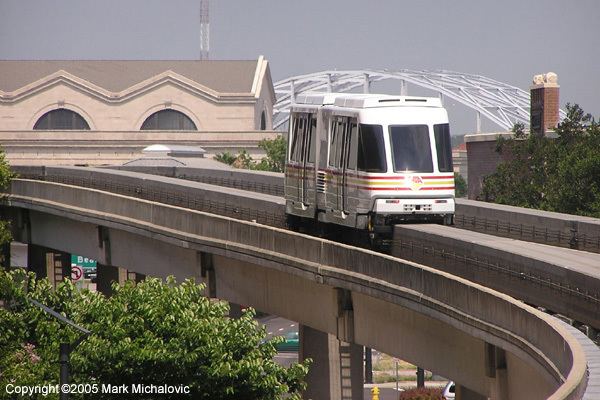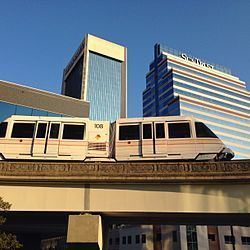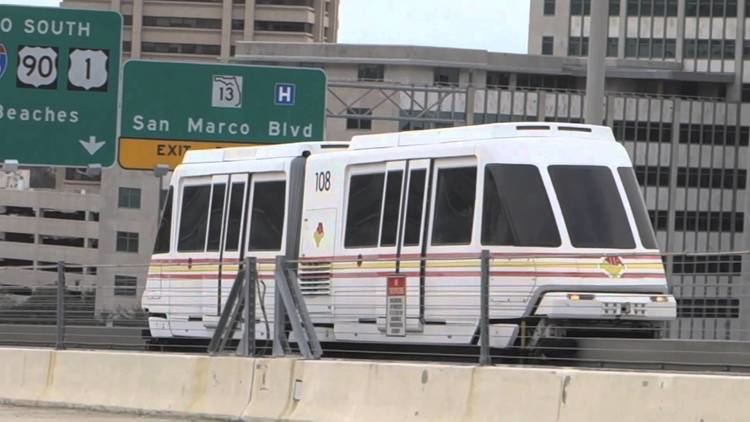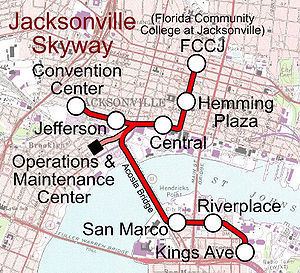Stations 8 Operator(s) JTA Track gauge Monorail | Status Operational Opened 1989 Locale Jacksonville | |
 | ||
Daily ridership 5,000 passengers(2015 estimate) Terminis Rosa Parks Transit Station (north), Convention Center station (west), Kings Avenue station (south) | ||
The Jacksonville Skyway is a people mover in Jacksonville, Florida, United States. It is an automated monorail train operated by the Jacksonville Transportation Authority (JTA). Opening in 1989 with three stations in Downtown Jacksonville, the Skyway was extended in 1996 following a conversion from its original technology to Bombardier Transportation equipment. It was expanded again in 1998 and 2000. The system currently comprises two routes across 2.5-mile (4.0 km) of track, serving eight stations, and crosses the St. Johns River on the Acosta Bridge. There is currently no fare to ride the Skyway, which had 1.2 million passengers in 2014.
Contents
- Jacksonville skyway monorail
- Description
- Planning and development
- Implementation and expansion
- Use
- Future
- Stations
- References

Jacksonville skyway monorail
Description

The Skyway runs on an elevated two-way monorail track. The 2.5-mile (4.0 km) system serves eight stations in Downtown Jacksonville: five in the Downtown Core and LaVilla areas, and three across the St. Johns River on the Southbank. There are two routes running south from Rosa Parks Transit Station and branching at Central station: one going west and terminating at Convention Center station, and the other going south over the river and terminating at Kings Avenue station on the Southbank.

The system has used two car and control systems since its creation. From 1989 to 1996 it had a system designed by Matra using its VAL 256-type rubber-wheeled technology. This ran only on the 0.7-mile (1.1 km), three station Phase I-A segment. In 1997, this was replaced by the current system designed by Bombardier Transportation, a version of its UM III monorail technology and 2 VAL cars were sold to O'Hare International Airport Transit System. In the current system, vehicles run on beams 34 inches (86 cm) wide and 28 inches (71 cm) deep, fixed on an 11-foot (3.4 m) wide guideway with parapet walls. Each train is automated by Automatic Train Control (ATC), can have two to six cars, and travels at up to 35 mph (56 km/h) per hour.
Planning and development

An automated people mover for Downtown Jacksonville was first proposed in 1972 to deal with traffic and parking issues in the urban core. In 1976, the city incorporated the system into its mobility plan, hoping to attract interest from the Urban Mass Transit Administration's Downtown Peoplemover Program. The initial study was undertaken by the Florida Department of Transportation and Jacksonville's planning department, who took the Skyway project to the Jacksonville Transportation Authority (JTA) in 1977 for further development. Early proposals recommended a comprehensive system over 4 miles (6.4 km) long that would connect into adjacent neighborhoods, but the project's route and scope were greatly reduced over the years to meet budget constraints and the UMTA's parameters.
After several stops and starts, the UMTA selected Jacksonville as one of seven cities to receive federal funding for the "Automated Skyway Express" in 1985. Two other related projects are Miami's Metromover and Detroit's People Mover. UMTA's approved plan called for the construction of a 2.5-mile (4.0 km) Phase I system to be built in three segments; the agency awarded JTA $23.5 million for the initial 0.7-mile (1.1 km) Phase I-A segment.
Implementation and expansion
In July 1987, JTA selected French company Matra to build the Phase I-A segment. Work completed in May 1989 at a cost of $34.6 million. At its opening the Skyway served three stations on its east-west route: Central, Jefferson, and Terminal Station (now Convention Center station) on the Northbank of Downtown Jacksonville. Subsequent extensions were planned to take the Skyway north to Florida Community College at Jacksonville (FCCJ), and then south across the St. Johns River over the Acosta Bridge. Development of these routes began in 1992 and 1995, respectively, but negotiations for a new contract with Matra failed when the previous one expired. In October 1994 Bombardier Transportation was awarded a new contract to revamp the existing east-west segment with new technology and to complete the remaining Phase I extensions.
The system was shut down on December 15, 1996 to replace the former Matra technology with Bombardier equipment; the older cars were sold to O'Hare International Airport in Chicago. The northbound extension was completed, adding the Hemming Plaza and Rosa Parks Transit Station stops, and the Skyway reopened on December 15, 1997, with service from the Prime F. Osborn III Convention Center to FCCJ. The southern segment opened on October 30, 1998, adding service to San Marco Station on Jacksonville's Southbank. On November 1, 2000, the Riverplace and Kings Avenue Stations opened, completing the Southbank segment and Phase I of the Skyway.
Use
Ridership on the Skyway has been far below initial projections; while JTA originally anticipated 100,000 riders monthly, it averaged less than a third of that by 2009. The primary reasons are the decline of the downtown workforce and lack of connections to other neighborhoods and modes of transit. The system became a major point of contention in Jacksonville, with critics considering it a "ride to nowhere" and a waste of resources. In 2010, after underperforming for over twenty years, The Florida Times-Union called it "a Jacksonville joke for a generation". However, others argued that expansion of the system and downtown revitalization could make it a success.
In February 2012, the Skyway was temporarily made free to ride until a new payment system was installed. Ridership jumped 61%—to 481,000 annually. Ridership in 2013 averaged nearly 4,000 on weekdays (the system is closed on weekends except for special events) and JTA has renewed the fare-free policy through the end of 2016. In light of this momentum, JTA Director Nat Ford has announced the agency will apply for grants to expand the system with a new station in the fast-growing Brooklyn neighborhood.
Future
In December 2015 the Jacksonville Transit Authority announced plans to review the installation and operation citing problems that "Skyway’s current vehicles are so old the parts can no longer be replaced — four of 10 vehicles are out of commission — and JTA staff said industry experts did not respond favorably to the possibility of overhauling them.". The review considered options to refurbish the current rolling stock, buy replacement vehicles, expand they system, tear down the structure or convert it to alternative use such as a walking path. In December 2016 preference was given for replacement of the present system with "autonomous vehicles" such as personal rapid transit or group rapid transit, however no final decision has been announced and public consulation continues. The JTA said in January 2017 that they are "trying to keep the Skyway operating for another five years as it determines the future of the system"
Stations
The Jacksonville Skyway has eight stations on two lines: the Northbank (Convention Center) line, and the Southbank (Kings Avenue) line. All trains run though Rosa Parks Transit Station, Hemming Park station, and Central station, where they split.
